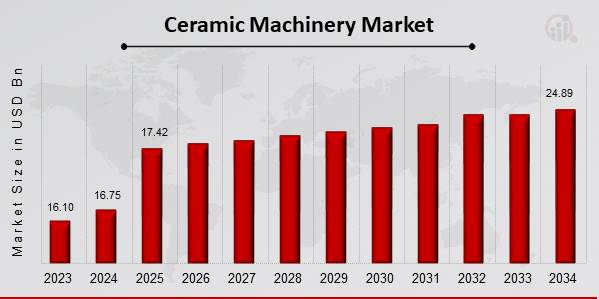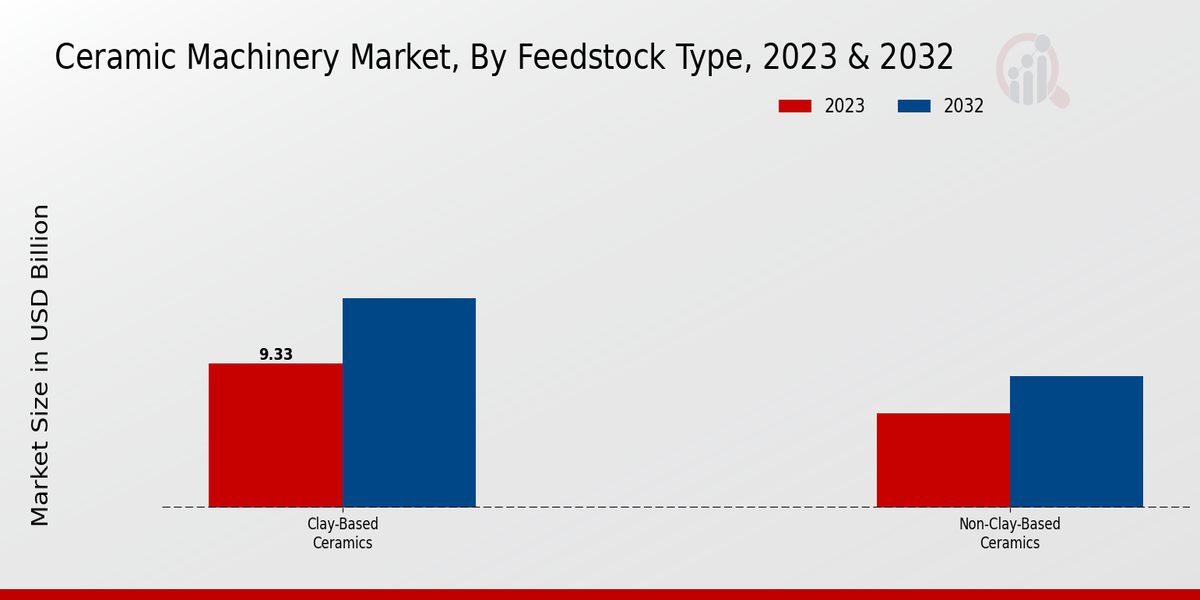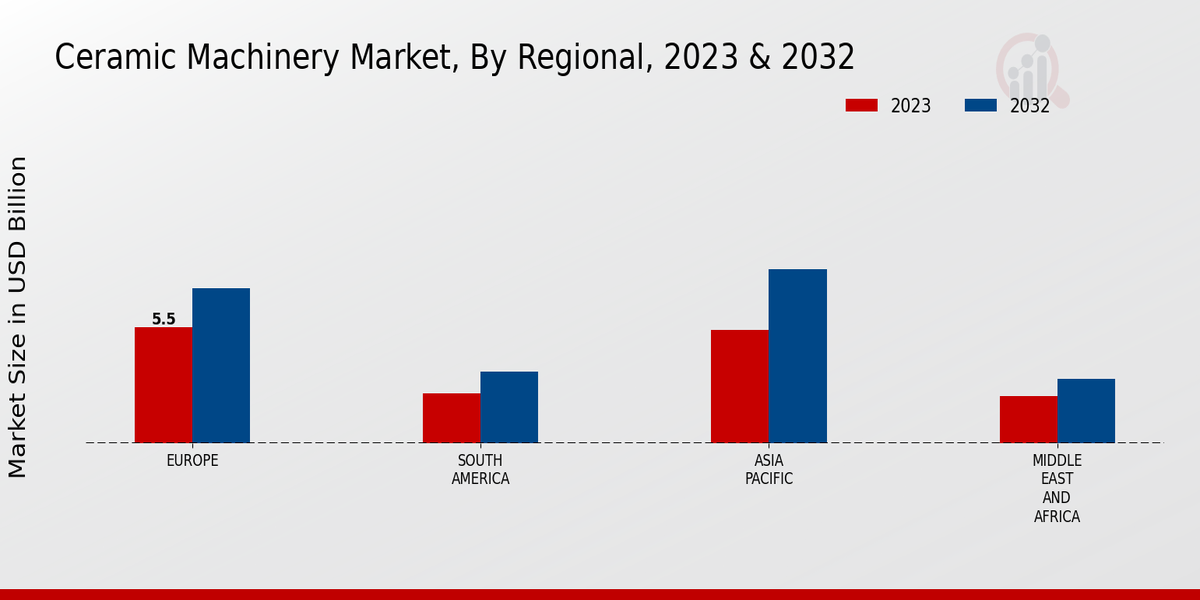Global Ceramic Machinery Market Overview
Ceramic Machinery Market Size was estimated at 16.75 (USD Billion) in 2024. The Ceramic Machinery Industry is expected to grow from 17.42 (USD Billion) in 2025 to 24.89 (USD Billion) by 2034. The Ceramic Machinery Market CAGR (growth rate) is expected to be around 4% during the forecast period (2025 - 2034).

Source: Primary Research, Secondary Research, MRFR Database and Analyst Review
Key Ceramic Machinery Market Trends Highlighted
The overall global market for ceramic machinery is likely to see further growth owing to the increasing popularity of ceramic products in various sectors such as construction, automotive, and electronics. Incorporating this new technology, such as automation and digitization, is changing the dynamics of the market by improving both the efficiency of production and the quality of products.
On the other hand, developing countries, including Asia Pacific and Latin America, provide a very encouraging picture of the growth of such a market. Increased urbanization and the increasing use of ceramic tiles for residential and commercial buildings provide an impetus for demand within these regions. Furthermore, the increased use of lightweight and high-strength ceramic components in the aerospace and defense industries presents new growth opportunities for the market.
Recent Ceramic pressing machine industry development mentioned above also includes industry 4.0 being implemented, which concentrates on the vertical, horizontal, and remote integration of data and automation. This variant will help cut operational costs and enhance the degree of customization of available products. Plus, the general enhancement of old products in the market has also been bringing about changes in ways of making ceramics, helping make green ceramics as usual.
Ceramic Machinery Market Drivers
Increasing Demand for Ceramics in Various Industries
The Ceramic Machinery Market is driven by the demand for ceramics in the construction, automotive, and electronics industries. Ceramics are used in the construction industry for the production of tiles, bricks, and sanitary ware due to their high strength, durability, heat resistance, chemical resistance, and wear resistance. The automotive industry uses ceramics to make engine components, brake pads, and catalytic converters. The ceramics have high-temperature resistance strength and wear resistance.In addition, the ceramics are hard; hence, they are scratch-resistant. The electronics industries are using ceramics to make substrates, capacitors, and insulators. The ceramics are also electrical insulators and resistant to high temperatures. The high demand for ceramics from the abovementioned industries is expected to drive the growth of the global ceramic machinery industry.
Technological Advancements in Ceramic Manufacturing
Technological advancements in ceramic manufacturing are another market driver. The market has triggered the development of more efficient and productive machinery, which in turn has decreased production costs and increased the quality of the final product. For example, the use of computer-aided design, or CAD, and computer-aided manufacturing, or CAM, software allows for the making of complex parts with high precision. Also, the development of new materials and processes, such as additive manufacturing and nanoceramics, respectively, has expanded our possibilities in ceramic manufacturing.Technological advancements appear to remain an important market driver for the next five years.
Government Initiatives and Regulations
Government initiatives and regulations are also expected to be among the drivers of growth for the ceramic machinery market. The trend toward the adoption of environmentally friendly and energy-efficient technologies is being promoted by the governments of many countries. As many types of ceramic machinery can be characterized by high energy efficiency and minimum environmental impact, demand for this type of equipment is growing. Similarly, the growth of markets in which ceramics are used because of initiatives implemented by governments, including the U.S., China, and several European countries, such as the construction and automotive industries, is set to drive the ceramic machinery market in the years to come.
Ceramic Machinery Market Segment Insights:
Ceramic Machinery Market Feedstock Type Insights
The Ceramic Machinery Market is segmented by Feedstock Type into Clay-Based Ceramics and Non-Clay-Based Ceramics. Clay-based ceramics held the largest market share at around 65% in 2023, which is further expected to grow during the forecast period. The growth of this segment is mainly due to the wide application of this product for construction, tiles, and sanitary ware. Furthermore, the huge demand for the product from developing economies and government initiatives to develop the infrastructure industry will also contribute to the growth of this segment.The Non-Clay-Based Ceramics segment, however, will grow at a steady speed throughout the forecast period. The growth of the segment is due to the increasing demand for advanced applications, including aerospace, electronics, and medical devices. The demand for ARCI and ceramic matrix composites in the aerospace industry will drive the growth of this segment. Moreover, the technological advancement and material developments in the segment will also contribute to the growth. The Ceramic Machinery Market is anticipated to witness significant growth in the next few years.The growth of the market is mainly due to increasing demand from end-users, including those in the construction, automotive, and electronics industries. Moreover, the government initiatives to promote sustainable and energy-efficient practices will also benefit the growth of the market as the ceramic machinery is used for the production of products that offer energy efficiency.

Source: Primary Research, Secondary Research, MRFR Database and Analyst Review
Ceramic Machinery Market Machine Type Insights
The “Ceramic Machinery Market” is segmented by machine type into forming machinery, finishing machinery, drying and firing machinery, glazing and decorating machinery, and other ceramic machinery. The forming machinery segment is the largest segment in the “Ceramic Machinery Market” and is expected to experience a growth rate of 4.2% during the forecast period. The finishing machinery segment is the second-largest segment and it is expected to record a growth rate of 4.1%. The drying and firing machinery segment is the third-largest segment, and it is expected to record a growth rate of 4.0%.The glazing and decorating machinery segment is the fourth largest segment, and it is expected to record a growth rate of 3.9%. The other ceramic machinery is the smallest and it is expected to record a growth rate of 3.8%. The growth of the “Ceramic Machinery Market” is influenced by various factors such as the growth of the construction industry, the growing demand for ceramic tiles and sanitary ware, and technological advancements in ceramic machinery. The construction industry is one of the major users of ceramic tiles and sanitary ware, and the growth of this industry is expected to propel the demand for ceramic machinery.The growing demand for ceramic tiles and sanitary ware, associated with the wide application of these products in residential, commercial, and industrial buildings, is expected to drive the growth of the “Ceramic Machinery Market.” Further, technological advancements in ceramic machinery are expected to drive the growth of the global market. These technological advancements are leading to the development of more efficient and productive ceramic machinery, which is expected to lower production costs and enhance the quality of the product.
Ceramic Machinery Market Application Insights
The Ceramic Machinery Market is segmented by Application into Construction, Sanitaryware, Tableware, Tiles, and Technical Ceramics. The Construction segment is projected to lead the market with a revenue share of 35.4% in 2024, driven by the increased demand for ceramic tiles and bricks in the construction industry. The Sanitaryware segment is expected to grow significantly due to rising demand for ceramic sanitaryware products such as sinks, toilets, and bathtubs. The Tableware segment is also poised for growth, owing to the increasing popularity of ceramic tableware in restaurants, hotels, and households.The Tiles segment is expected to witness steady growth due to the rising demand for ceramic tiles for flooring and wall cladding applications. The Technical Ceramics segment is projected to grow at a moderate pace, driven by the increasing use of ceramic materials in various industrial applications such as electronics, aerospace, and automotive.
Ceramic Machinery Market Degree of Automation Insights
The Ceramic Machinery Market segmentation by Degree of Automation includes Manual, Semi-Automatic, and Fully Automatic. The Fully Automatic segment held the largest market share in 2023, accounting for around 38.4% of the Ceramic Machinery Market revenue. The increasing adoption of automation in ceramic manufacturing processes to enhance efficiency, reduce labor costs, and improve product quality is driving the growth of the Fully Automatic segment. Moreover, government initiatives to promote Industry 4.0 and smart manufacturing are further fueling the adoption of fully automated ceramic machinery.The Semi-Automatic segment is also expected to witness significant growth during the forecast period due to its cost-effectiveness and ability to balance automation with manual intervention. The Manual segment is expected to hold a steady market share, as it remains a viable option for small-scale ceramic manufacturers and for processes where manual control is preferred.
Ceramic Machinery Market End-User Industry Insights
The end-user industry segment plays a crucial role in shaping the dynamics of the Ceramic Machinery Market. Among the key end-user industries, the building and construction sector holds a significant market share due to the increasing demand for ceramic tiles, bricks, and sanitary ware in residential and commercial construction projects. The automotive industry is another major consumer of ceramic machinery, particularly for the production of ceramic components used in engine parts, brake systems, and exhaust systems. The aerospace industry utilizes ceramic machinery to manufacture lightweight and high-temperature resistant components for aircraft engines and other critical applications.The electronics industry employs ceramic machinery for the production of ceramic substrates, capacitors, and other electronic components. Lastly, the healthcare industry utilizes ceramic machinery to manufacture medical devices, implants, and dental prosthetics due to the biocompatibility and durability of ceramic materials. The growth of these end-user industries is expected to drive the demand for ceramic machinery in the coming years, contributing to the overall market growth.
Ceramic Machinery Market Regional Insights
Regionally, the market is segmented into North America, Europe, APAC, South America, and MEA. North America held the largest market share in 2023, accounting for around 35%. Europe and APAC are other prominent regions in the market, with significant market shares. The growth in the ceramic machinery market in these regions can be attributed to the increasing demand for ceramic products, particularly in the construction and automotive industries. The rise in construction activities, coupled with government initiatives to promote sustainable building practices, is driving the demand for ceramic machinery in North America and Europe.Similarly, the expanding automotive industry in APAC is contributing to the growth of the ceramic machinery market in the region.

Source: Primary Research, Secondary Research, MRFR Database and Analyst Review
Ceramic Machinery Market Key Players And Competitive Insights:
The ceramic Machinery Market industry is highly competitive, with several established players. Leading Ceramic Machinery Market players include SACMI, System Ceramics, LB, Tenova, and others. These companies have a strong presence in the Ceramic Machinery Market and offer a wide range of products and solutions. They invest heavily in research and development to stay ahead of the competition and cater to the evolving needs of customers. The development of the Ceramic Machinery Market is driven by several factors, such as the increasing demand for ceramic tiles, sanitary ware, and other ceramic products in emerging economies, technological advancements, and the growing focus on automation in manufacturing processes. The Ceramic Machinery Market Competitive Landscape is likely to remain highly competitive in the years to come, with new entrants entering the market and established players expanding their product portfolios as well as reach.SACMISACMI is a leading global provider of Ceramic Machinery Market solutions. The company offers a comprehensive range of products and services, including tile presses, dryers, kilns, and digital printing solutions. SACMI has a strong presence in the ceramic industry and caters to the needs of customers worldwide. The company is committed to innovation and invests heavily in research and development to develop new and better products and solutions. SACMI’s ability to satisfy customers and its capability of providing customized solutions have played a significant role in its success in the Ceramic Machinery Market. SACMI is also active in other sectors, such as closures and containers, beverage, and packaging, among others.LBLB is another major player in the Ceramic Machinery Market. The company is a specialist in the production of tile presses and serves the Chinese market. It offers various tile presses, ranging from small scale manual presses to large scale automatic presses. The company is known for its high-quality products and commitment to customer satisfaction. LB’s emphasis on innovation and its capability of offering cost-effective solutions have been instrumental in its success in the Ceramic Machinery Market.
Key Companies in the Ceramic Machinery Market Include:
- Topy Industries, Ltd.
- Diopside Minerals Ltd.
- Riedhammer GmbH Co. KG
- Shinagawa Refractories Co., Ltd.
- Nabertherm GmbH
- Imerys Refractories
- Morgan Advanced Materials
- Luoyang Luyang Refractories Co., Ltd.
- Maerz Ofenbau AG
- Sibelco Group
- RHI Magnesita
- SACMI Imola S.c.
- L Products
- ZTech Corporation
- Vesuvius
Ceramic Machinery Market Industry Developments
The Ceramic Machinery Market is poised to experience steady growth, driven by increasing demand for ceramic tiles and sanitary ware. In 2023, the market was valued at USD 15.47 billion and is projected to reach USD 22.1 billion by 2032, exhibiting a CAGR of 4.04%. Technological advancements such as digital printing and automation are expected to bolster market growth. Recent developments include the launch of eco-friendly ceramic machinery by SACMI and the acquisition of LB Officine by Tenova, indicating a focus on sustainability and consolidation within the industry. The Asia-Pacific region is anticipated to hold a dominant market share due to rising construction activities and urbanization. Key players in the market include Sacmi, LB Officine, Tenova, and Ancora.
Ceramic Machinery Market Segmentation Insights
- Ceramic Machinery Market Feedstock Type Outlook
- Clay-Based Ceramics
- Non-Clay-Based Ceramics
- Ceramic Machinery Market Machine Type Outlook
- Forming Machinery
- Finishing Machinery
- Drying and Firing Machinery
- Glazing and Decorating Machinery
- Other Ceramic Machinery
- Ceramic Machinery Market Application Outlook
- Construction
- Sanitaryware
- Tableware
- Tiles
- Technical Ceramics
- Ceramic Machinery Market Degree of Automation Outlook
- Manual
- Semi-Automatic
- Fully Automatic
- Ceramic Machinery Market End-User Industry Outlook
- Building and Construction
- Automotive
- Aerospace
- Electronics
- Healthcare
- Ceramic Machinery Market Regional Outlook
- North America
- Europe
- South America
- Asia Pacific
- Middle East and Africa
| Report Attribute/Metric |
Details |
| Market Size 2024 |
16.75 (USD Billion) |
| Market Size 2025 |
17.42 (USD Billion) |
| Market Size 2034 |
24.89 (USD Billion) |
| Compound Annual Growth Rate (CAGR) |
4% (2025 - 2034) |
| Report Coverage |
Revenue Forecast, Competitive Landscape, Growth Factors, and Trends |
| Base Year |
2024 |
| Market Forecast Period |
2025 - 2034 |
| Historical Data |
2019 - 2023 |
| Market Forecast Units |
USD Billion |
| Key Companies Profiled |
Topy Industries, Ltd., Diopside Minerals Ltd., Riedhammer GmbH Co. KG, Shinagawa Refractories Co., Ltd., Nabertherm GmbH, Imerys Refractories, Morgan Advanced Materials, Luoyang Luyang Refractories Co., Ltd., Maerz Ofenbau AG, Sibelco Group, RHI Magnesita, SACMI Imola S.c., L Products, ZTech Corporation, Vesuvius |
| Segments Covered |
Feedstock Type, Machine Type, Application, Degree of Automation, End-User Industry, Regional |
| Key Market Opportunities |
Growing construction industry, increasing urbanization, rising disposable incomes, technological advancements and expanding consumer base |
| Key Market Dynamics |
Shifting consumer preferences Technological advancements Rising urbanization Growing demand for ceramic tiles Increasing government investments |
| Countries Covered |
North America, Europe, APAC, South America, MEA |
Frequently Asked Questions (FAQ) :
The Ceramic Machinery Market is anticipated to reach a valuation of approximately 16.10 billion USD in 2023.
The Ceramic Machinery Market is projected to expand at a CAGR of around 4% from 2025 to 2034.
Asia-Pacific region is anticipated to lead the Ceramic Machinery Market due to the increasing demand for ceramic products in the region.
Ceramic machinery is primarily used in the production of ceramic tiles, sanitary ware, tableware, and other ceramic products.
Prominent players in the Ceramic Machinery Market include Sacmi Imola S.C., LB, SITI BT Group, Tenova, and others.
Rising demand for ceramic products, technological advancements, and increasing construction activities are among the key factors propelling the growth of the Ceramic Machinery Market.
Fluctuating raw material prices, intense competition, and stringent environmental regulations are some of the challenges faced by the Ceramic Machinery Market.
The Ceramic Machinery Market is projected to reach a valuation of approximately 24.89 billion USD by 2034.
Technological advancements, such as automation and digitalization, are anticipated to enhance efficiency and productivity, thereby positively impacting the Ceramic Machinery Market.
Increasing adoption of Industry 4.0 technologies, growing demand for customized ceramic products, and emphasis on sustainable manufacturing are some of the key trends shaping the Ceramic Machinery Market.

















